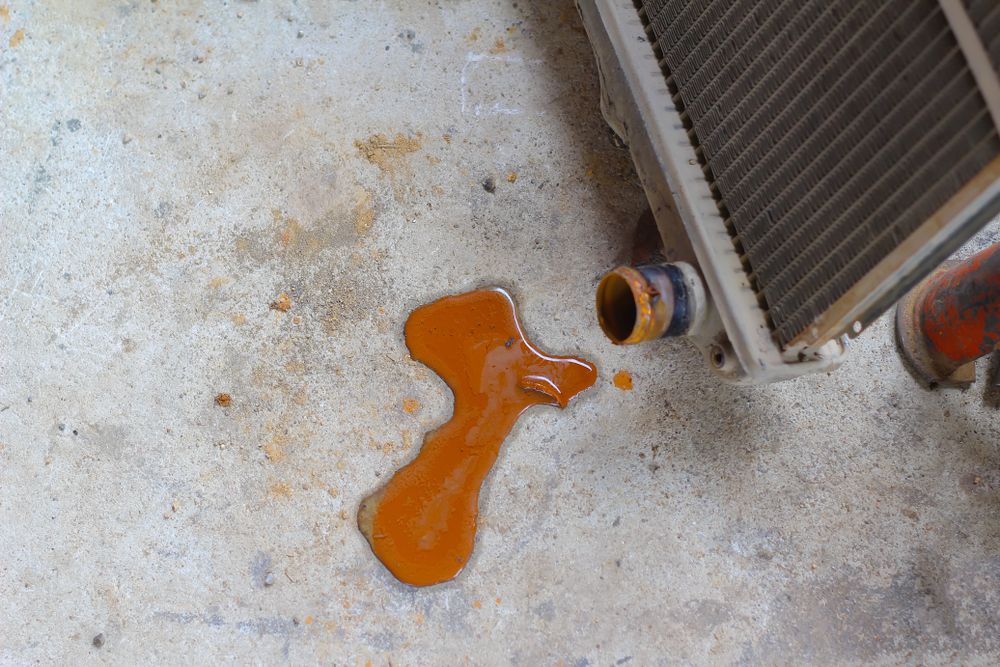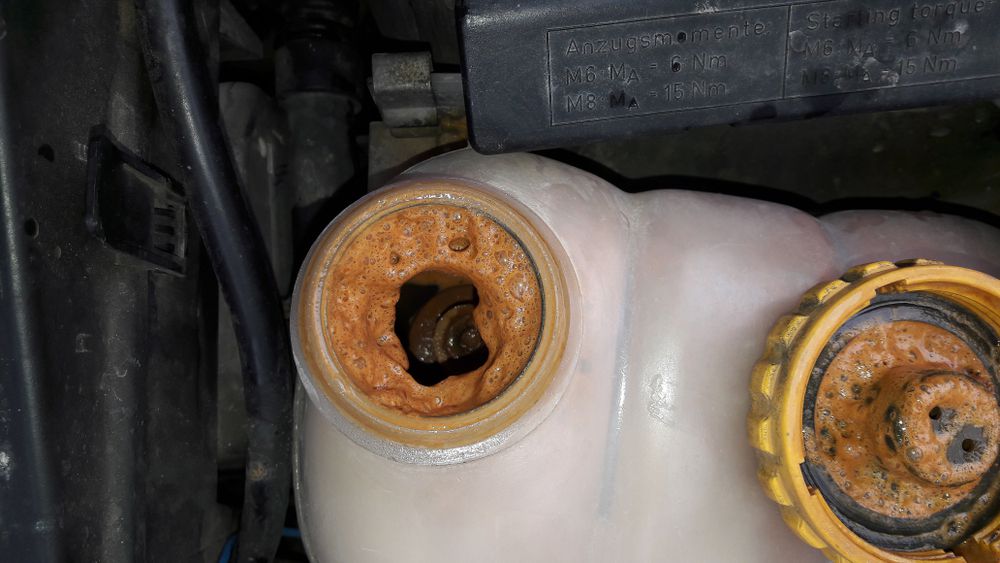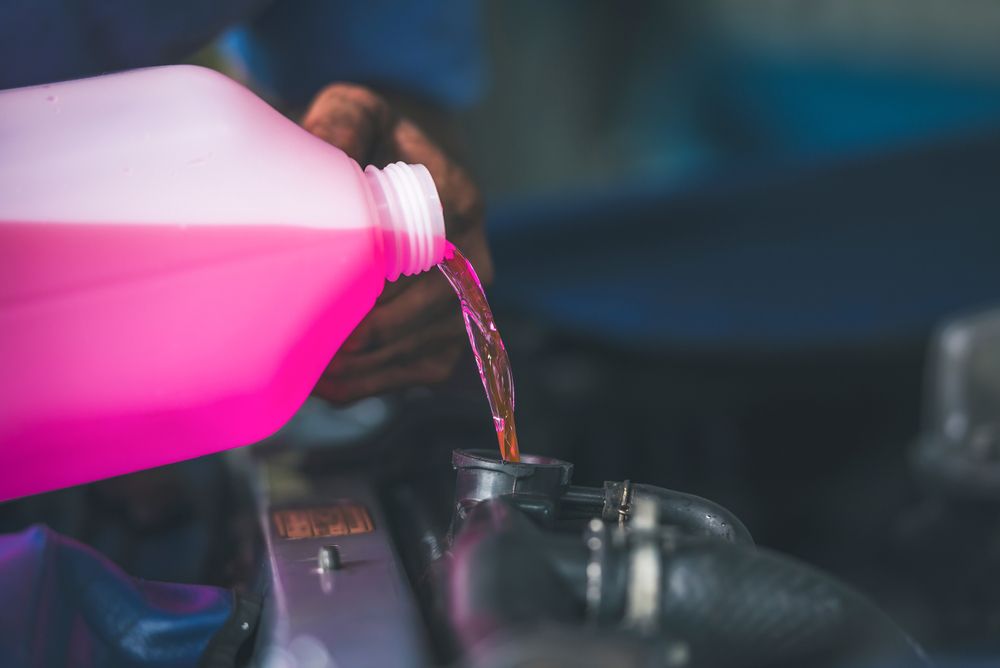
If you have ever had your car overheat on you, you know the importance of
keeping your engine cool. And there is one special fluid that helps keep
your engine cool: coolant. Coolant goes through your car's radiator, water
hoses, and engine to keep it from overheating.
If your engine coolant is rust-brown, it means the coolant is too
contaminated to cool the engine properly and must be changed. If the
rust-brown coolant is sludgy, the problem is serious. Rust brown or
sludgy coolant should be flushed immediately to avoid severe engine
damage.
 Rust colored engine coolant.
Rust colored engine coolant.
Why Did My Coolant Turn Brown?
Your coolant will turn rust brown due to contamination buildup. Over time,
your coolant will oxidize, introducing rust into the system.
This will make it turn a brownish color in appearance.
Is Brown Coolant Normal?
Coolant that is rust brown is not normal. The color of clean coolant can
vary - typical colors include green, red, and orange, and fresh coolant is
also translucent.
Rust-brown coolant in your coolant system, especially opaque and sludgy,
means the coolant is dirty or contaminated.
 Sludgy coolant in the coolant reservoir.
Sludgy coolant in the coolant reservoir.
How Do I Fix Brown Sludge In My Radiator?
The best way to fix rust-brown sludge in your radiator is to do a coolant
flush.
If there is brown sludge in your radiator rather than just rusty, you should take your car to a mechanic as it could be a severe problem.
Of course, you can flush your coolant by taking it to an auto mechanic's
shop, but if you want to avoid driving too far in a car with bad coolant,
there is a way to do it at home.
Before you start, ensure your car is off, and the engine is cool.
This is especially true about opening up your radiator cap - doing it while
the coolant is hot will cause serious injuries.
Getting Your Supplies Together
First, grab your supplies - a funnel, a drain pan, a screwdriver, and a
wrench.
Be sure to have distilled water and antifreeze or coolant on hand. Next,
find the radiator and the round cap sitting on it.
Don't worry about it just yet; just note where it is.
Drain Your Radiator
Next, crawl under the vehicle and look for a valve or hose that connects to
the radiator.
Place your drain pan under it, and then undo the hose or open the valve.
The contaminated coolant will begin to drain rapidly and immediately, so be
careful, or it'll be a bit messy.
Let it drain for about 10 to 15 minutes to ensure it has had time to clear
out.
Then, close up the valve or reconnect the hose.
Refill Your Radiator With Distilled Water and Drain Again
Open the radiator cap and pour the water into the radiator until it's full,
then replace the cap and turn your vehicle on.
Let it run for 10 or 15 minutes, shut it off, and wait until the engine
cools.
Drain your radiator again (another 10 to 15 minutes), and then close it up.
You can also remove the drain pan.
 Adding new coolant to a radiator.
Adding new coolant to a radiator.
Replace Your Coolant
Return to your radiator and put a half-and-half blend of water and
antifreeze into the radiator or the fresh coolant.
Fill it until the coolant reaches the service line on the overflow tank (a
semi-translucent plastic tank), also known as your coolant tank.
Close up the cap and start the car.
Check under your radiator and make sure that nothing is leaking.
If you've done everything right, congratulations - you have flushed the
coolant in your car's cooling system.
What Are The Signs Of A Blown Head Gasket?
White smoke from your exhaust, loss of coolant, and an overheating engine
are indicators of a blown head gasket.
If you see any of the following signs, you might have a blown or a leaking
head gasket:
1. White Smoke From Your Exhaust
White smoke from your tailpipe means an engine coolant leak or a head
gasket failure.
2. Bubbling In The Radiator
Bubbling or boiling coolant means rising air pressure in the engine cooling
system caused by an air pocket.
3. Loss Of Coolant
A clear sign of coolant loss is if you are low on coolant but don't have a
leak.
4. White Color In The Oil
This is a sign of coolant mixing with your engine oil.
5. Overheating Engine
Your coolant will be acting abnormally, so your engine will not be cooled
correctly.
6. A Loss Of Engine Power
A blown head gasket allows fuel or air to escape from the cylinders, which
means a loss of engine performance.
7. Antifreeze Smell
Antifreeze leaks, including head gasket leaks, can cause a sweet or antifreeze smell in the vehicle's cabin.
Can You Drive With A Blown Head Gasket?
If you can get the vehicle started, you can drive on a blown head gasket, but it is not a good idea.
A head gasket prevents coolant from entering the various compartments in
your engine block.
The more you drive on it, the more damage it can cause to your engine
block.
Can I Add New Coolant To Old Coolant?
You can add new coolant to your old coolant if you use the same coolant,
though this is not recommended.
Mixing old and new coolants will cause the old coolant to become more
acidic with time, which can cause engine damage.
Mixing incompatible coolants will result in reactions that can make your
coolants into jelly or sludge that will cease cooling your engine.
If you believe that your car needs new coolant, it is best to drain it
before adding the new coolant.
How Much Does A Coolant Flush Cost?
The cost of a coolant flush average between $100 and $150.
A coolant flush may be more or less expensive depending on your vehicle
type and how it is flushed (an auto repair shop may use certain chemicals
to flush the system).
In contrast, if you decide to do it yourself, a coolant flush will run you
somewhere between $20 and $30 dollars.
Conclusion
Brown coolant in your system is a serious problem in your cooling system.
You should change out the brown coolant before your engine overheats. If
you have any issues with your car's cooling system, address them
immediately.